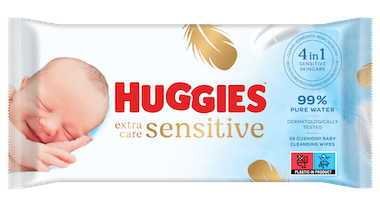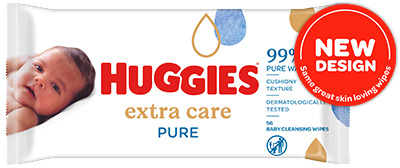Anxious about your newborn’s first nappy change? We get it. So to help you get started, we created a fool-proof guide.
How to change a nappy: a step-by-step guide
First time parent? Don’t worry if you’re all fingers and thumbs at first. After a few times, you’ll be an expert at baby changing. All it takes is 10 quick steps:
- Lie your baby down
- Open the nappy up
- Clean up the nappy
- Wipe your baby front to back
- Gently apply the nappy cream
- Clean around the umbilical cord
- Slide on a fresh nappy
- Fix the nappy in place
- Keep the nappy clear of the umbilical cord
- Make sure the nappy is secure
1. Lie your baby down
Gently lie your baby on their back on the changing mat. Undo and then remove the clothing on their lower half and move out of the way.
Remember, at this or at any stage during the changing process, keep close to your little one and never leave them unattended.
2. Open the nappy up
Undo the tapes at the front of the nappy and open it up. If it’s just wet, raise your baby’s legs and bottom and slide it out.
3. Clean up the nappy
If the nappy is dirty, use the nappy to clean off most of the area. You might need to use a wipe at this stage to clean some of the poo, then slide the dirty nappy away.
4. Wipe your baby front to back
Using a gentle baby wipe, clean all the nappy area. Wipe from front to back.
5. Gently apply the nappy cream
Apply nappy cream if required and massage in.
6. Clean around the umbilical cord
Clean around the umbilical cord and dry (the cord will drop off by itself a couple of weeks after birth)
7. Slide on a fresh nappy
Gently raising your baby’s legs and lower body by the ankles, slide a fresh nappy under their bottom. Let the legs down.
8. Fix the nappy in place
Bring the front of the nappy up to lay it on their belly, pick up the 'wings' of each side of the nappy and stick the stretchy tape on them onto the front of the nappy.
9. Keep the nappy clear of the umbilical cord
Fold down the waistband of the nappy at the front so that it is not rubbing on the umbilical cord. Some newborn nappies have a cut-away here.
10. Make sure the nappy is secure
Lastly, to prevent any little accidents, run a finger around the inside of the leg 'cuffs' to pull them out. All done!
Nappy changing tips and tricks
Mum Hebe has seen it all when it comes to changing nappies. That’s why we’ve asked her to share her tricks and tips to help you make nappy changing as stress-free as possible.
What do you need when changing nappies?
Firstly, make sure you have all you need to hand next to the area you have chosen to change your baby’s nappy. This may be a changing unit with a mat on top, or a changing mat on the bed, or the floor. Gather these items before starting:

Find out about Huggies® Pure Extra Care
- Nappies
- Wipes
- Nappy cream
- Nappy caddy/organiser
- Nappy bin or biodegradable nappy sacks
- The changing mat
- A change of clothes
NEVER leave your baby unattended
Nappy changing on the go?
Pack an identical kit in your changing bag and make sure you refill it each time you get home. Add some biodegradable nappy sacks.
How often should I change my baby’s nappy?
Nappies should be changed every time your baby poos. Modern nappies are designed to be absorbent, so they can hold two to three wees but do change it if it feels heavy and swollen. Not changing your baby’s nappy frequently can lead to nappy rash.
Should you change a dirty nappy immediately?
While you can leave a nappy on that has a small amount of urine in it, you should change your baby’s nappy when they poo. It can irritate the skin, leaving it sore. It can also lead to UTIs if left unchanged.
How do I change a baby boy’s nappy?
It’s a little tricky when changing boys, as they can wee in all directions! When you remove a nappy, have a wipe or clean flannel handy and quickly place it over your little boy’s penis to catch unexpected wee.
How do I change a baby girl’s nappy?
It’s a little easier to change girls, as they aren’t capable of such spectacular weeing but do remember that it’s important to wipe from front to back to avoid urinary tract infections (UTIs).
Should I use nappy cream at every change?
Nappy rash can be quick and easy to treat. At the first signs of raw, red, or chapped skin, use a good quality nappy rash cream; your Health Visitor can advise which cream to use. Allow nappy free time, as above.
Is nappy changing gross?
Many parents worry that they’ll find changing their baby’s nappy disgusting but it’s not that bad! In fact, it can provide an excellent opportunity for both new mums and dads to bond with their baby. Small babies don’t have terribly smelly poo, especially if breastfed. Just be aware that a few days after the birth, they may pass a black or greenish poo. This is meconium, a substance that has filled your baby’s intestines in the womb.
How can I tell if the nappy fits my baby?
Nappies are designed to fit babies by weight, so check the packet. It should be snug (not tight) around the waist, with no gaps around the legs. The nappy should not leave any red marks.
What position should my baby be in for a nappy change?
This is a matter of personal preference, with some parents preferring to change their baby lying sideways, others with the head away from you. Gently pick up your baby’s legs and bottom by holding both their feet in one of your hands, using the other to clean and change.
Supporting every step of your parenting adventure
From changing your first nappy to helping your little one stay dry at night, we’re here as your parenting partner, whenever you need us.
To get you started on your new adventure, have a read of our newborn essentials checklist. And if you’re really thinking ahead, we’ve even got a guide on when it’s best to start weaning.



 your parenting partner
your parenting partner